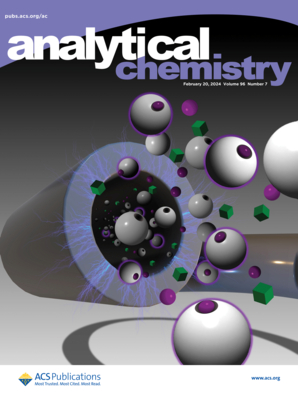通过减压电离使蛋白质增压到接近理论极限。
IF 6.7
1区 化学
Q1 CHEMISTRY, ANALYTICAL
引用次数: 0
摘要
众所周知,电喷雾电离(ESI)可以产生多种带电的蛋白质离子。较高的电荷态通过提高碎片效率和增加序列覆盖率来增强串联质谱(MS/MS)。然而,蛋白质充电的程度可能受到许多因素的限制,包括与周围气体的质子转移反应。在这里,我们证明了液滴在减压下的脱溶显着增加了蛋白质的电荷状态,特别是当与化学增压添加剂(如1,2-丁烯碳酸酯)结合时。使用减压纳米电喷雾电离(250 Torr),观察到细胞色素c (12.6 kDa)和肌红蛋白(16.7 kDa)的最大电荷态分别从24+和32+(在环境条件下)增加到30+和40+,在其真空电荷态预测极限的15%之内。对于较大的蛋白质,也实现了增强的充电。例如,碳酸酐酶(29 kDa)和牛血清白蛋白(66.5 kDa)在减压下达到62+和112+的电荷状态,而在环境压力下为46+和92+。这些结果表明,将减压脱溶与化学增压相结合是一种有效的方法,可以将ESI中蛋白质的电荷态提高到接近理论极限,并为自上而下的大分子分析提供优势。本文章由计算机程序翻译,如有差异,请以英文原文为准。
Supercharging Proteins to Near the Theoretical Limit via Reduced Pressure Ionization.
Electrospray ionization (ESI) is well-known for generating multiply charged protein ions. Higher charge states enhance tandem mass spectrometry (MS/MS) by improving fragmentation efficiency and increasing sequence coverage. However, the extent of protein charging can be limited by many factors including proton transfer reactions with ambient gases. Here, we demonstrate that droplet desolvation under reduced pressure significantly increases protein charge states, especially when combined with chemical supercharging additives such as 1,2-butylene carbonate. Using reduced pressure nanoelectrospray ionization (250 Torr), the maximum observed charge states of cytochrome c (12.6 kDa) and myoglobin (16.7 kDa) increased from 24+ and 32+ (under ambient conditions) to 30+ and 40+, respectively, within 15% of their predicted in vacuo charge state limits. Enhanced charging was also achieved for larger proteins. For example, carbonic anhydrase (29 kDa) and bovine serum albumin (BSA, 66.5 kDa) reached charge states of 62+ and 112+ under reduced pressure, compared to 46+ and 92+ at ambient pressure. These results demonstrate that combining reduced pressure desolvation with chemical supercharging is an effective approach for increasing protein charge states in ESI to near the theoretical limit, and should offer advantages for the top-down analysis of large biomolecules.
求助全文
通过发布文献求助,成功后即可免费获取论文全文。
去求助
来源期刊

Analytical Chemistry
化学-分析化学
CiteScore
12.10
自引率
12.20%
发文量
1949
审稿时长
1.4 months
期刊介绍:
Analytical Chemistry, a peer-reviewed research journal, focuses on disseminating new and original knowledge across all branches of analytical chemistry. Fundamental articles may explore general principles of chemical measurement science and need not directly address existing or potential analytical methodology. They can be entirely theoretical or report experimental results. Contributions may cover various phases of analytical operations, including sampling, bioanalysis, electrochemistry, mass spectrometry, microscale and nanoscale systems, environmental analysis, separations, spectroscopy, chemical reactions and selectivity, instrumentation, imaging, surface analysis, and data processing. Papers discussing known analytical methods should present a significant, original application of the method, a notable improvement, or results on an important analyte.
 求助内容:
求助内容: 应助结果提醒方式:
应助结果提醒方式:


